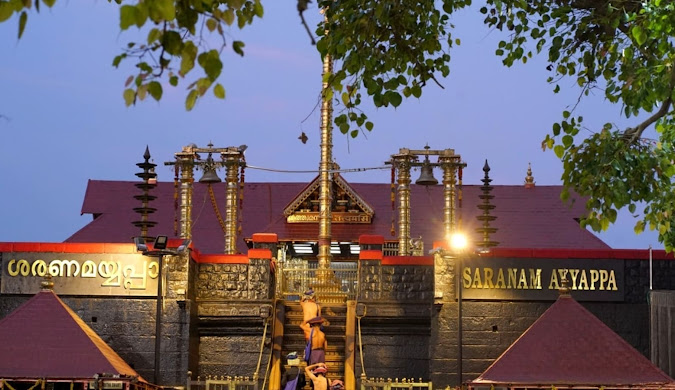The Ayyappa Swami Temple at Sabarimala is one of the most important Hindu pilgrimage centers in the world. Located in the Western Ghats mountains of Kerala, India, the temple is dedicated to Lord Ayyappa, a celibate deity who is said to be the son of Shiva and Vishnu.
The Sabarimala pilgrimage is a challenging one, both physically and spiritually. Devotees must undertake a 41-day vow of abstinence before they are allowed to enter the temple. This vow includes abstaining from sex, alcohol, and non-vegetarian food. Devotees also wear simple white robes and carry an irumudikettu, a sacred bundle containing their belongings.
The pilgrimage begins at the Nilackal base camp, where devotees register and pick up their irumudikett. From there, they embark on a 14-kilometer trek through the dense forests of the Western Ghats. The trek is steep and challenging, but the pilgrims are sustained by their faith and the support of their fellow devotees.
After completing the trek, the pilgrims arrive at the Sannidhanam, the main temple complex. The Sannidhanam is home to the Ayyappan Swami Temple, as well as a number of other temples and shrines.
The highlight of the pilgrimage is the darshan, or glimpse of Lord Ayyappa. The darshan takes place at the Ayyappan Swami Temple, and is a truly moving experience for the pilgrims.
The Sabarimala pilgrimage is a unique and unforgettable experience. It is a time for spiritual reflection and renewal, and for coming together with other devotees to celebrate their faith in Lord Ayyappa.
Here is a detailed analysis of the Ayyappa Swami Temple:
- Historical and Mythological Significance:
- The history of the temple dates back several centuries, and it is closely associated with the legend of Lord Ayyappa’s birth. It is believed that Lord Ayyappa was born from the union of Lord Shiva and the enchantress Mohini, and he was destined to fulfill a divine mission.
- Pilgrimage and Devotees:
- Sabarimala is one of the largest annual pilgrimage sites in the world, attracting millions of devotees, especially during the annual Mandala Pooja and Makaravilakku festivals (November to January). Pilgrims, often referred to as “Ayyappans,” undertake a rigorous 41-day fast and adhere to strict vows and rituals before visiting the temple.
- Gender Restriction:
- One of the most controversial aspects of the temple is the age-old restriction that prevents women of menstruating age (10 to 50) from entering the temple. This restriction has been a subject of legal and social debate in recent years.
- Unique Temple Practices:
- The pilgrimage to Sabarimala involves numerous unique practices, including wearing black or blue clothes, carrying the “Irumudi” (a double-pouch offering containing ghee-filled coconut, among other items), and climbing the 18 sacred steps known as “Pathinettam Padi.”
- Rituals and Offerings:
- The temple has a well-defined set of rituals, including the “Neyyabhishekam” ritual in which devotees offer ghee to the deity. Coconuts, camphor, and flowers are also commonly offered as part of the worship.
- Temple Architecture:
- The temple’s architecture is a classic example of the Kerala-style temple architecture, with its gopuram (entrance tower), intricate woodwork, and stunning sculptures. The temple complex is surrounded by lush forests, adding to its natural beauty.
- Ecological Concerns:
- Sabarimala is situated in the heart of the Periyar Tiger Reserve, and the heavy influx of pilgrims has raised concerns about its ecological impact. Efforts are being made to balance the religious significance of the temple with the need for ecological conservation.
- Legal and Social Issues:
- The restriction on women’s entry to the temple has been a subject of legal battles, with various judgments and changes in the stance of the temple authorities and state government. This issue reflects the broader debate about gender equality and religious practices in India.
- Festival Celebrations:
- The annual Mandala Pooja and Makaravilakku festivals are grand celebrations, featuring processions, lighting of the Makaravilakku (a sacred flame), and other cultural events. These festivals are attended by a large number of devotees.
- Spiritual and Cultural Significance:
- The Ayyappa Swami Temple holds immense spiritual and cultural significance in the state of Kerala and among devotees worldwide. It is not just a place of worship but also a symbol of devotion, self-discipline, and communal harmony.
Tips for visiting the Ayyappa Swami Temple
- The best time to visit the Ayyappa Swami Temple is during the Mandala season, which runs from mid-November to mid-January.
- Devotees must undertake a 41-day vow of abstinence before they are allowed to enter the temple.
- Devotees must also wear simple white robes and carry an irumudikettu, a sacred bundle containing their belongings.
- The pilgrimage begins at the Nilackal base camp, where devotees register and pick up their irumudikett. From there, they embark on a 14-kilometer trek through the dense forests of the Western Ghats.
- After completing the trek, the pilgrims arrive at the Sannidhanam, the main temple complex. The Sannidhanam is home to the Ayyappan Swami Temple, as well as a number of other temples and shrines.
- The highlight of the pilgrimage is the darshan, or glimpse of Lord Ayyappa. The darshan takes place at the Ayyappan Swami Temple, and is a truly moving experience for the pilgrims.


Leave a Reply